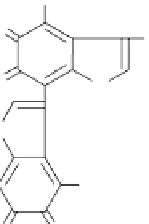Geoscience Reference
In-Depth Information
O
O
N
H
HN
O
O
Figure 8.7. Melanin type structure resulting from the Maillard reaction of carbohydrates and amino
acids.
exponential growth phase of phytoplankton (Stedmon and Markager,
2005b
). In addition,
the experimental evidence revealed that there is a close interplay between photochemical
exposure and microbial degradation. The production of some of the humic fluorescence
signals during these dark incubations was dependent on pre-exposure of the samples to
photodegradation.
Recent work by Romero-Castillo et al. (
2010
) with axenic phytoplankton cultures
appears to refute the suggestion that phytoplankton do not directly produce humic fluor-
escence. Their results show that both amino acid-like and humic-like FDOM signals are
generated. The production of amino acid-like fluorescence agrees with earlier field and
experimental observations (e.g., Stedmon & Markager,
2005b
). Humic-like fluorescence,
as mentioned previously, has otherwise been attributed to microbial turnover of otherwise
colorless DOC released. So it would appear that this issue warrants further study. In a series
of studies, Urban-Rich et al. (
2004
, 2006) have also shown that zooplankton grazing and
excretion are a source of both humic- and amino acid-like fluorescence. Again the latter
is to be expected as proteins of most aquatic organisms will to some extent contain tryp-
tophan and tyrosine (e.g., Determann et al.,
1998
). The generation of humic-like fluores-
cence, however, is more intriguing and slightly counterintuitive. These broad fluorescence
peaks are often associated with larger more complicated conjugated structures, so an alter-
nate hypothesis could be that abiotic condensation processes may also be responsible.
In some of the earliest work on DOM fluorescence and marine humic matter summa-
rized in Duursma (
1965
) it is suggested that a reaction similar to the Maillard reaction, well
known as being responsible for the browning of food, may be responsible for producing
this humic fluorescence signal. In this reaction carbohydrates and amino acids condensate
to produce compounds with a melanin structure (Hedges,
1978
) (
Figure 8.7
). Potentially
this type of reaction can occur, as both these groups of compounds are known to be released
by phytoplankton (Nagata,
2000
) and are often detected in seawater DOM (Benner,
2002
).
The fact that they are labile to bacteria can explain why these relatively simple and ubiqui-
tously produced structures represent so little of the DOC. Free concentrations in seawater
are very low, so if this type of reaction is responsible it must be occurring rapidly in or

